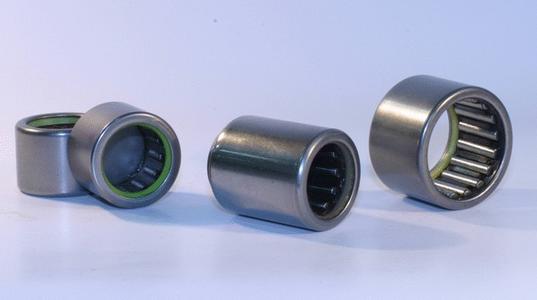
Needle bearings are roller bearings with rollers that have high length-to diameter ratios. They are used in farm and construction equipment, automotive transmissions, small gasoline engines, gear pumps, small appliance and tool motors, alternators, and aircraft controls.
Needle bearings are roller bearings with rollers that have high length-to diameter ratios. They are used in farm and construction equipment, automotive transmissions, small gasoline engines, gear pumps, small appliance and tool motors, alternators, and aircraft controls.
Needle bearings are usually lubricated with grease, but oil or oil-mist lubrication is preferred for heavy-duty or high-speed applications. Many light-duty bearings never require relubrication, but high loads or speeds demand it.
Compared with other roller bearings, needle bearings have much smaller rollers for a given bore size. They have the highest load capacity for a given radial space of all rolling-element bearings, but their use is limited to bore diameters less than 10 in.
All needle bearings are variations of two basic designs. The first, full complement, has a full complement of needles and contains no retainer. The second, caged needle, contains a retainer or cage for roller guidance and spacing. Caged bearings have smaller roller complements and lower load capacities than full-complement bearings. Their advantage is a higher speed capacity; retainers prevent high-velocity rubbing between adjacent needles and provide more effective roller guidance. They also have greater lubricant capacity.
Loose-needle bearings are simply a full complement of needles in the annular space between two hardened machine components, which form the bearing raceways. They provide an effective and inexpensive bearing assembly with moderate speed capability, but they are sensitive to misalignment.
Caged assemblies are simply a roller complement with a retainer, placed between two hardened machine elements that act as raceways. Their speed capability is about three times higher than that of loose-needle bearings, but the smaller complement of needles reduces load capacity for the caged assemblies.
Drawn-cup, full-complement bearings consist of a deep-drawn cup (the outer race) with a full complement of needles. In some designs the needles are retained by the cup lips, in others they are retained by the grease. Spherical-ended, rather than trunnion-ended, rollers are used in the grease-retained bearings, which give a slight gain in load capacity.
Drawn-cup, caged bearings are dimensionally identical to full-complement bearings, except that a retainer is used. As usual, the retainer and reduced complement provide higher speeds and reduced load capacity. In addition, the caged bearing has somewhat better tolerance for misalignment than the full-complement bearing.
Heavy-duty bearings are made with relatively heavy outer rings, made from hardened and precision-ground materials. Their load capacity is high because of the retainer-guided end-relieved rollers.
Cam followers or track followers are heavy-duty needle bearings with either an integral stud or a nonseparable inner ring that accepts a yoke-mounting stud. The basic follower can include almost any combination of special features such as seals, self-lubricating rings, eccentric-mounted studs, crowned outer races, heavy-duty studs, and a variety of platings and coatings.
Aircraft bearings are heavy-duty compact assemblies that have maximum load capacity under static, oscillating, or slowly rotating conditions. The single-roller types have low tolerance to misalignment. Some double-roller types have a two-piece outer race that compensates for misalignment. All types are provided with grooves and oil holes for relubrication through the shaft or housing.
Thrust bearings are caged bearings with rollers assembled like the spokes of a wheel in a waferlike retainer. These bearings can operate at fairly high speeds, despite some continuous slippage between the roller and raceway surfaces, which occurs because the rollers are cylindrical rather than tapered.
Machine Design
No Comments